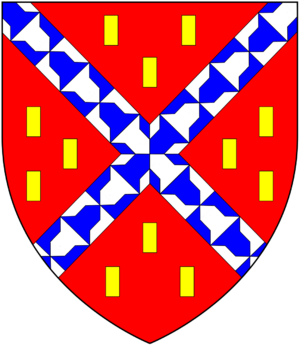Arthur Champernowne facts for kids
Quick facts for kids
Arthur Champernowne
|
|
|---|---|

Arms of Champernowne: Gules, a saltire vair between twelve billets or
|
|
| Member of Parliament for Barnstaple |
|
| In office 1547–1552 |
|
| Member of Parliament for Plympton Erle |
|
| In office 1555–1555 |
|
| Member of Parliament for Plymouth |
|
| In office 1559–1559 |
|
| Member of Parliament for Totnes |
|
| In office 1563–1567 |
|
| Personal details | |
| Born | 1524 |
| Died | 1 April 1578 (aged 53–54) Dartington Hall |
| Resting place | church of St Mary, Dartington |
| Spouse | Mary Norris |
| Children |
|
| Parents |
|
Sir Arthur Champernowne (born around 1524 – died 1 April 1578) was an important English politician, soldier, and a high sheriff (a top law enforcement officer in a county). He lived at Dartington Hall in Devon, England.
His family, the Champernownes, came from Normandy in France. After the Norman Conquest in the 1000s, they gained land in Devon. You might see his name spelled a few different ways, like Champernon, Chamborne, or Chapman. This was common in the 1500s when spelling wasn't as fixed as it is today.
Sir Arthur had famous relatives. His aunt, Lady Kat Ashley, was the governess (teacher and caregiver) to Queen Elizabeth I. Also, the famous explorers Sir Walter Raleigh and Sir Humphrey Gilbert were his nephews.
Contents
Sir Arthur Champernowne's Life and Career
Arthur Champernowne was the second son of Sir Philip Champernowne. His mother was Katherine Carew. He served in the English army during the Siege of Boulogne when England was worried about an invasion.
In 1549, he helped stop a rebellion known as the Prayer Book Rebellion. This uprising wanted to bring back the Latin Bible instead of the English version. The rebellion started in Cornwall, where the Cornish language was still widely spoken. For his role in stopping this rebellion, he was made a knight on November 10, 1549.
Champernowne was a strong protestant. He was briefly involved in a plan to support Lady Jane Grey as queen. However, he wisely decided to accept Mary Tudor as the new queen. In 1552, he became a Member of Parliament (MP) for Barnstaple.
In early 1554, he was held in the Tower of London but was later released. Even though Queen Mary's government didn't want him in office, he was chosen as a local Justice of the Peace (JP) in 1555. He was then elected as an MP for Plympton Erle in 1555, Plymouth in 1559, and Totnes in 1563.
Sir Arthur held several important positions:
- 1552 – MP for Barnstaple
- 1555 – MP for Plympton
- 1559 – MP for Plymouth
- 1559 – Sheriff of Devon
- 1562 – Vice-Admiral of the Devon Coasts (a role he held for life)
- 1563 – MP for Totnes
When Queen Elizabeth I came to power, Sir Arthur became very involved in naval matters. As Vice-Admiral, he worked to stop French pirates who were bothering ships near England's western coast. He also sometimes worked with privateers (private ships allowed to attack enemy ships) from Jeanne d'Albret, the Protestant Queen of Navarre, against Catholic Spain.
In 1568, he played a key role in a famous event. Many Spanish ships carrying treasure for the Duke of Alva (a Spanish leader in the Netherlands) were forced into English ports. Sir Arthur helped take control of this treasure. He personally delivered 64 boxes of treasure, weighing about 8 tons, to the Tower of London. This treasure was worth a huge amount of money at the time. Queen Elizabeth used more than half of it to fund her navy.
Supporting Protestants in France
Sir Arthur was a strong supporter of protestantism. In 1572, his son Gawen married the daughter of Gabriel, Count of Montgomery, a Huguenot (French Protestant). The Count was a captain of the Scots Guards. Sir Arthur was in France for the wedding and reported back to Lord Burghley, a key advisor to Queen Elizabeth, about the situation there.
After the terrible St. Bartholomew's Day Massacre (where many Protestants were killed in France), Count Montgomery escaped and found safety at Dartington Hall. Sir Arthur wrote to Queen Elizabeth suggesting they raise an army to help the Protestants in France.
In 1574, he led a rescue mission, but it didn't go as planned. Count Montgomery had already been captured and executed. Sir Arthur's fleet could only help the Huguenot captains in La Rochelle.
Sir Arthur continued to support naval efforts against France. He wrote his will in March 1578 and passed away at Dartington Hall on April 1, 1578.
Sir Arthur's Family and Home
In 1546, Sir Arthur married Mary, who was the widow of Sir George Carew. Mary was the daughter of Henry Norris. Sir Arthur and Mary had five sons and one daughter:
- Gawen (died 1592), who married Roberte de Montgomery.
- Philip
- Charles
- George
- Edward
- Elizabeth, who married Sir Edward Seymour, 1st Baronet.
In 1554, Sir Arthur traded some property to gain the Dartington estate, which included the old Dartington Hall. By 1560, he began building a new Elizabethan-style front onto the older buildings, a project that took several years. His family continued to live at Dartington Hall for many generations until it was sold in 1925.

